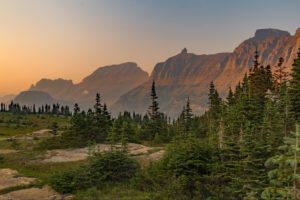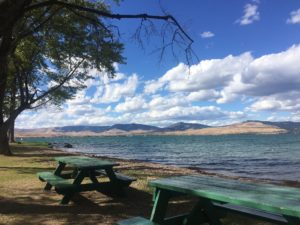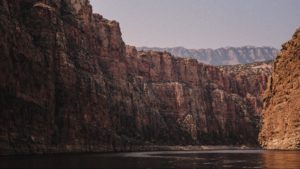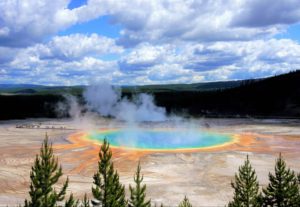Looking for the next great adventure? Put Montana on your travel bucket list! Montana is a part of Lewis and Clark’s Peaks to Plains region, which covers the states of Montana and Idaho, and is among the most underrated states for outdoor recreation and activities. But why exactly should you choose to specifically visit Montana along the Lewis and Clark National Historic Trail (LCNHT)?
Hear from expert Pat Doyle, who is a marketing manager at the Montana Department of Fish, Wildlife and Parks, or Montana Fish, Wildlife & Parks for short. He explains what his role entails, and the responsibilities of his government agency to manage state-owned park resources, and the sustainability of Montana’s great outdoors. He also shares some of the must-sees and hidden gems of Montana that all visitors traveling along the LCNHT should know about before heading out the front door. Here’s why you should visit Montana along the Lewis and Clark National Historic Trail.

A stunning view of Glacier National Park, Montana
Why Montana Tourism?
Despite Montana being the 4th largest state in the United States, this state has a low population density with only 1.062 million inhabitants. That makes it the 43rd most populous state! Additionally, there are 12 Native American tribes living in Montana, representing 6.5 percent of the state’s total population. This Northwestern state is part of the 16 states and tribal lands that make up the National Historical Lewis and Clark Trail. The trail’s history can be traced back to Meriwether Lewis and William Clark’s exploration of the western portion of the United States following the Louisiana Purchase; they were the first explorers who were a part of the United States that managed to cross Montana during their expedition that lasted from 1804 until 1806.
Today, Montana remains the same wild and preserved land that it was over 200 years ago. What makes Montana unique from other states is its hidden beauty that is often overshadowed by neighboring states. As a plus, it has unlimited outdoor recreation potential due to the topography of the land that most tourists aren’t aware of. It is also home to one of the biggest and most popular national parks in the country — Yellowstone. What is more, many of the sites in Montana hold great cultural and historic significance, which only contributes to the hidden beauty of this state.
Although Montana outside of Yellowstone is not advertised as a default tourist destination, Pat Doyle agrees that Montana offers serene views unlike no other state in the U.S., and tourism outreach is a priority for informing Americans of Montana’s unique outdoor recreation activities. “There is a lot of untapped potential, and I don’t think Montana is ever going to be a historical tourist destination. But, I think that there can be a lot more done to develop a lot of those assets on the ground,” Pat confirmed.
What exactly does Montana Fish, Wildlife & Parks do? How does it benefit Montana tourism?
Montana Fish, Wildlife & Parks’ role is to “provide for the stewardship of fish, wildlife, parks and recreational resources of Montana while contributing to the quality of life for present and future generations.” As a marketing manager, Pat’s role centers around communicating and gaining relevancy for high-profile issues, such as Chronic Wasting Disease (CWD), which is invasive across aquatic species, as well as developing the Landowner Relation Program. He is also involved in partnering with people across the tourism industry and economic development spectrum by discussing the value of Montana’s state parks, as well as the state’s historical sites and cultural areas.
When asked about his role, Pat replied, “For me personally, the most rewarding parts of it are working with our state-wide cultural and historic sites, which many of our state parks make up. And I think one of the challenging parts relates specifically to state parks, that people aren’t necessarily cognizant of who is managing what property.” He briefly mentioned that many people do not recognize the difference between national and state parks. Pat clarified that national parks have a national significance, which is also a state park’s attribute, but state parks also exist to display the history and culture of said state.
Montana Fish, Wildlife & Parks has a variety of different funding sources. Some examples include the state putting excise taxes on ammunition and fishing supplies and an optional fee for registered vehicles that go directly into supporting the state government’s mission to protect Montana’s state parks. “Pittman Robertson and Dingle Johnson funding are national taxes that are levied on those kinds of supplies, and then we are fortunate that in Montana, all of our parks are free for the residents, but they do have the option when they register their vehicle every year to pay an optional $9 fee that goes back to the operations and maintenance of our parks. We’re really lucky that the vast majority of people who register their cars pay that fee,” Pat commented.
Each and every one of the funding sources used to protect Montana’s backyard are important in their own right, as each of them has a specific purpose. For example, Pat revealed that “Pittman Robertson funding money can only go to things like wildlife habitats […] Dingle Johnson money can go to the water-based conservation and recreation things, and our State Park funding really has to stick with our state parks, so it can be for cultural and historic preservation purposes.”
Where should I visit in Montana?
Montana is an underrated state rich in natural resources and beauty. Don’t just hear it from us — here is the anticipated list of all of the must-see locations that Pat Doyle mentioned, and are perfect for any visitor eager to explore Montana.

This could be you relaxing at Flathead Lake, Montana
1. Flathead Lake
Flathead Lake is a large natural lake in Northwest Montana and features several small islands with a variety of fish species. It sits to the south of Glacier National Park, and with so much wildlife in the area, it is a truly wonderful destination for everyone to visit. The lake is highly accessible and gives countless recreational opportunities for kayaking, sailing adventures, fishing and many more.
2. Bighorn Canyon National Recreation Area
Bighorn Canyon National Recreation Area is a vast and massive landscape with over 12,000 acres, and it offers visitors the opportunity to experience natural wildlife, ecosystems and many more. Whether you’re interested in camping, hiking or boating — the recreation area is a perfect place for such adventures. It has two visitor centers — one near Fort Smith in Mont. and one near Lovell, Wyo.

Breathtaking scenery at Bighorn Canyon, Montana
3. Upper Missouri River Breaks National Monument
Upper Missouri River Breaks in central Montana is one of my favorite places in the States,” Pat replied while discussing Montana’s top destinations for any tourist, visitor, or local.
This monument protects the Missouri Breaks of North Central Montana with the landscape containing an array of biological, wildlife and cultural resources. The monument is covered with sedimentary rocks that covered central and eastern Montana during the Cretaceous period. Thanks to its remote location, the site is still in its original condition and now offers countless cultural tourism opportunities.
4. First Peoples Buffalo Jump State Park
This state park is a National Historic Landmark (NHL) in Cascade County, Mont. and is believed to be the largest bison cliff jump in North America. The site holds significant historical and cultural value as it was used by Indigenous Americans for thousands of years before Lewis and Clark passed through that area. The park has a visitor center, interpretive trail, picnic tables and a protected black-tail prairie dog town to help visitors understand the captivating history of hunting on the High Plains.
Yellowstone National Park and sustainable Montana tourism
Montana is extremely lucky to be home to one of the most popular national parks in the U.S., Yellow Stone National Park. Unfortunately, Yellowstone has been dealing with over tourism over the past several years. We asked Pat what he thinks of the situation and how this challenge could be solved with sustainable tourism, while promoting what Montana has to offer outside of the National Parks.
“One of the things that we do see, specifically in the case of international visitors is that the first time they come to the United States, it’s mostly New York, L.A., Disney World, and when they reach Montana, they’re primarily coming for Yellowstone or Glacier. So if they do want to come back after they’ve seen those two parks and explore off-the-beaten paths parts in Montana, that’s usually their second or third visit to the U.S., so it might not be easy,” Pat said. As a result, Montana’s government is working on promoting sustainable tourism and being respectful while visiting any state or national parks. Montana tourism is doing the background work
Pat also mentioned that state parks in the U.S. have different systems, and they are differently operated and funded. “When people are coming to a national park, they may have an expectation of a visitor experience that we can’t back up at our state parks.” Therefore, it can be really hard to fulfill the users’ expectations when trying to spread people across different sites and even different states. Pat agrees that state parks offer the same incredible experience that national parks offer to millions of visitors per year.

Pictured is the Grand Prismatic Spring located in Yellowstone National Park, Montana
As you can see, Montana is an incredibly diverse state that is rich in wildlife, cultural and historic resources. No matter where your interests lie, Montana has a place for you. Thanks to Montana Fish, Wildlife & Parks’ hard work, the government agency does an incredible job of protecting the state’s natural assets while communicating their value and significance for the tourism economy. Therefore, we must all work together to protect the great outdoors by being conscious of our actions as visitors and tourists so that generations to come can enjoy Montana’s beauty. Hopefully, you now feel inspired to stop by Montana while traveling along the LCNHT, and you are ready to experience all of the fantastic sights that it has to offer.
Want to learn more about Montana Tourism? Visit our website to learn about the top things to do and see in this beautiful state.
